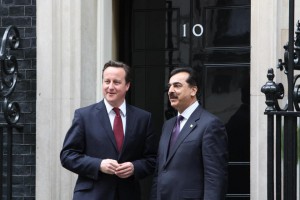28th May 2012 London, UK
When two Prime Ministers met: an insider’s view
 You’ve seen the photographs of the Prime Ministers outside the door of Number 10 Downing Street. But after the politicians and cameras have left, what does it add up to?
You’ve seen the photographs of the Prime Ministers outside the door of Number 10 Downing Street. But after the politicians and cameras have left, what does it add up to?
I’m one of the behind-the-scenes people in London and Islamabad. You won’t see any of us in the photos, but we’re the ones who made it happen and now implement the decisions. I could roll off the official achievements from the summit, but you can get that from elsewhere. I want to give you the insider’s view.
For me, the real benefit is how it got us behind-the-scenes people working together. It gave us those essential ingredients for making things happen: clear, shared objectives with a deadline attached. The High Commission and Foreign Office (in London and Islamabad) were talking daily, building relations that will keep on delivering. You know co-operation is going well when a British civil servant willingly gives out their personal mobile number.
Within our governments, we had serious discussions about priorities – when Prime Ministers meet, everything is potentially on the agenda, so what makes the cut? Trade, culture, economic development, security and education all made it. That gives us our focus and mandate going forward.
Our contacts beyond government intensified too, working with parliament, business leaders and British Pakistani organisations. I got to meet Black Rod, best known for knocking on the door of the House of Commons to summon Members of Parliament to hear the Queen’s speech, but in my case to discuss where the Prime Minister of Pakistan would be seated for the ceremony. In research for the cultural roadmap, I discovered that 150 schools in Pakistan are linked with 90 schools in the UK, improving their knowledge and understanding of other cultures while another 38 Pakistani schools are linked to 20 specialist sports-schools in the UK to encourage participation in sport in this Olympic year.
That might all sound a little prosaic, the oiling of bureaucratic wheels. However, when our goal is practical co-operation on a broad range of issues that are in our mutual interests, that’s what will get us there. People to people contacts, in government and beyond, are the foundation of our relationship.
What am I most proud of achieving from the visit? The joint statement . Well, I would say that, as I not only work in communications but helped negotiate it. But I take more than just personal pride. It both sums up where UK-Pakistan relations are and sets the scene for where they are going. Because at the British Pakistan Foundation dinner, the chair of one of the English County Cricket Boards, who had seen what the joint statement says on cricket, offered his expertise directly to the Prime Minister of Pakistan. Because it will help us to start conversations on topics that some find it difficult to talk about, such as democracy and illegal migration. Because when we talk to British businesses thinking about investing in Pakistan, we can say with confidence that they have the full support of the Prime Minister of Pakistan and the Prime Minister of the United Kingdom.
So one handshake on the doorstep of Number 10 Downing Street is leading to many more handshakes, even if they are away from the glare of the camera.
Excellent post, very good insight. I agree with the above comment regarding the UK’s historical ties with Pakistan. We should try and strengthen those, even in the face of recent problems
“Britain and Pakistan’s relations have more length, breadth and depth than any other country. It’s not just government to government; the people to people ties are intense, too